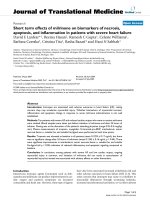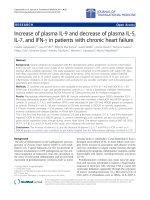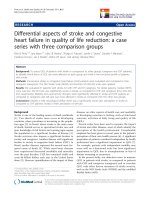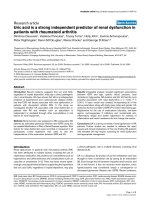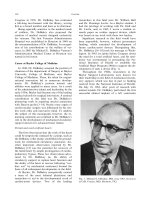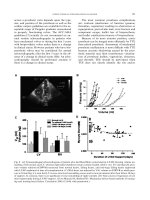Renal dysfunction in heart failure paitients
Bạn đang xem bản rút gọn của tài liệu. Xem và tải ngay bản đầy đủ của tài liệu tại đây (982.95 KB, 8 trang )
Journal of military pharmaco-medicine no5-2018
RENAL DYSFUNCTION IN HEART FAILURE PAITIENTS
Nguyen Duy Toan*; Le Thi Ngoc Han*
Tran Duc Hung *; Nguyen Oanh Oanh*
SUMMARY
Background: In clinical practice, renal dysfunction is common and associated with
re-hospitalization and reduced survival in patients with heart failure. Objectives: To determine
the prevalence, characteristics of renal function in heart failure patients and to investigate the
relationship between reduced renal function with the degree of heart failure, left ventricular
ejection fraction, serum BNP. Methods and results: In 95 patients with heart failure at
Department of Cardiology, 103 Military Hospital from 2016 November to 2017 April, 52.6% of
the patients had worsening renal function. Mean NYHA functional class was 3.34 ± 0.63 for
-1.
-2
-1.
-2
eGFR < 60 mL.min 1.73m higher than 3.06 ± 0.69 for eGFR ≥ 60 mL.min 1.73m (p < 0.05).
There was a significant correlation between eGFR and left ventricular ejection fraction with
r = 0.54 (p < 0.001). There was a reversal correlation between eGFR and serum BNP level with
r = -0.25 (p < 0.01). Conclusions: The more severe HF was, the less eGFR was. Estimated GFR
correlated positively with left ventricular ejection fraction and negatively with BNP concentration
in patients with HF.
* Keywords: Heart failure; Renal dysfunction; Estimated glomerular filtration rate (eGFR).
INTRODUCTION
to monitor, treatment and prognosis of
patients with HF.
Heart failure (HF) is a serious condition
with high mortality despite all modern
treatment. Many factors contribute to the
poor outcome in HF. Renal dysfunction
occurs in acute and chronic HF, is associated
with reduced survival [4, 5]. Prevalance of
renal dysfunction is common, related to
prognosis, treatment of HF. Otherwise,
HF can have similarly detrimental effects
on renal function. This intersection between
cardiac and renal insufficiencies, the so-called
“cardio-renal” interaction is associated
with increased rates of morbidity and
mortality in patients [8, 9]. Therefore,
investigation of renal dysfunction is necessary
Objectives: To determinate the prevalence,
characteristics of renal dysfunction in HF
patients and investigate the relationship
between renal function and the degree of
HF, ejection fraction, serum BNP.
SUBJECTS AND METHODS
1. Subjects.
95 patients with HF at Department of
Cardiology, 103 Military Hospital from
November 2016 to April 2017. For each
patient, baseline data was recorded on the
form including demography, causes of HF,
clinical status, echocardiographic findings,
serum B-type natriuretic peptide (BNP).
*
Corresponding author: Nguyen Oanh Oanh ()
Date received: 05/03/2018
Date accepted: 24/03/2018
180
Journal of military pharmaco-medicine no5-2018
* Renal function: The measurement of
renal function was carried out by estimated
Glomerular Filtration Rate (eGFR) using
the Modification of Diet in Renal Disease
(MDRD) equation: eGFR = 0.881 × 186 ×
(serum creatinine + 0.2 in mg/dL)-1.154 ×
(age in years)-0.203 × (0.742 if female)
mL.min-1.1.73m-2. All patients were.characterized
by their renal function: normal (eGFR ≥ 90
mL·min-1·1.73m-2), light renal dysfunction
(eGFR < 90 and ≥ 60 mL·min-1·1.73 m-2),
moderate to severe renal dysfunction
(eGFR < 60 mL·min-1·1.73 m-2) [9].
* Statistical analysis:
Data was processed using statistical
methods in medicine with software package
SPSS version 21.0 for windows.
RESULTS
1. Patient characteristics.
Table 1: Baseline patient characteristics according to baseline eGFR.
-1
Characteristics
Demography
Age (years) (mean ± SD)
Male, (%)
2
BMI, (kg/m )
Cause of HF, (%)
Ischemic
Hypertension
Diabetes mellitus
Hb concentration, (g/L)
NYHA functional class
NYHA II
NYHA III
NYHA IV
Serum BNP, (pg/mL)
Total (n = 95)
-2
eGFR (mL.min ·1.73 m )
p
< 60 (n = 50)
≥ 60 (n = 45)
70.2 ± 12.5
66.3
21.1 ± 2.6
73.4 ± 12.2
58.0
21.2 ± 4.0
66.1 ± 14.0
63.4
21.5 ± 4.5
< 0.05
> 0.05
> 0.05
24.4
51.6
19.0
36
64
22
11.1
37.7
15.5
< 0.05
< 0.05
> 0.05
124.1
117.0 ± 19.8
130.2 ± 20.6
< 0.05
3.21 ± 0.67
13 (13.6%)
49 (51.6%)
33 (34.8%)
3.34 ± 0.63
3 (6%)
32 (64%)
15 (30%)
3.06 ± 0.69
10 (24.2%)
17 (37.8%)
18 (40%)
< 0.05
1511.8 ± 1445.7
1875.0 ± 1612.8
1108.2 ± 1117.4
< 0.01
Mean age, BNP and NYHA function class of the patients with eGFR < 60 ml.min.1.73 m-2 was higher than that of the patients with eGFR 60 ml.min-1.1.73 m-2.
1
Figure 1: Distribution of eGFR.
The majority of HF patients had eGFR < 60 ml.min-1.1.73m-2 (64.41%).
181
Journal of military pharmaco-medicine no5-2018
Figure 2: Relationship between eGFR and LVEF.
The rate of patients with eGFR < 60 ml.min -1.1.73m -2 in the group LVEF < 50%
was almost twice as high as that of the group LVEF ≥ 50%. This difference is
statistically significant.
(r = 0.521316; p < 0.001; eGFR = 0.9224 LVEF + 21.386)
Figure 3: The correlation between eGFR and LVEF.
There was a significant positive correlation between eGFR and LVEF. The linear
regression showed that EF decreased by 1% when the eGFR decreased 0.9224
mL.min-1.1.73m-2.
182
Journal of military pharmaco-medicine no5-2018
(r = -0.251108304; p < 0.01; eGFR = -0.0043[BNP] + 68.678)
Figure 4: The correlation between eGFR and serum BNP level.
There was a significant reversal correlation between eGFR and serum BNP levels.
The linear regression showed that serum BNP levels increased by 100 pg.ml-1, whereas
the eGFR decreased by 0.43 mL.min-1.1.73m-2.
DISCUSSION
1. General characteritics of HF patients
with renal dysfunction.
Table 1 shows mean age of this study
group was 70.2 ± 12.5 years and 66.3%
were males. HF etiology was ischemic in
24.4%, hypertensive in 51.6%and diabetes
mellitus in 19.0%, which was similar to
that reported in previous cohort studies
and clinical trials.
The level of GFR is usually regarded
as the best overall index of the level of
kidney function. Serum creatinine is
determined by a number of factors, other
than GFR, such as gender, age, muscle
mass and ethnicity and therefore, it provides
only a rough estimate of level of kidney
function. To provide a more accurate
measure of kidney function, we estimated
GFR using a recently validated formula
from the MDRD study, which has been
shown to be a more accurate measure of
kidney function than serum creatinine
or creatinine clearance estimated using
either the Cockcroft Gault equation [9].
The prevalence of CKD in this study
(52.6%) was similar to that reported in
previous cohort studies and clinical trials.
The previous cohort studies found 47 64% of HF patients with an eGFR < 60
mL.min-1.1.73m-2.
The heart and kidney functions are
closely linked together by haemodynamics,
neurohormones and the sympathetic
nervous system [3]. The kidney is sensitive
to haemodynamic changes, such as an
increased central venous pressure
(renal afterload) and a reduced cardiac
183
Journal of military pharmaco-medicine no5-2018
output (renal preload). In patients with
decompensated HF, increased central
venous pressure and/or intra-abdominal
pressure are strong determinants of
increased serum creatinine levels.
Reduced cardiac output is another major
determinant of renal impairment in HF.
The kidneys are richly innervated by
efferent sympathetic nerve fibres and the
renal sympathetic drive is markedly increased
in HF [5], [6].
Table 2. The prevalence of HF patients
with eGFR < 60 mL.min-1.1.73m-2 in studies.
In the early stages of chronic HF, GFR is
well-maintained by compensatory increases
in filtration fraction; in patients with more
severe chronic HF, GFR becomes more
dependent on afferent arteriolar flow and
the stimulation of hemodynamic and
hormonal pathways. Furthermore, the fall in
effective renal blood flow is relatively more
pronounced and therefore disproportional to
the reduction in cardiac output. Traditionally,
the contribution of the kidneys to chronic
HF has been considered as an adaptive
response mechanism evoking a series of
compensatory neurohormonal changes,
in particular, increased adrenergic drive and
activation of the RAAS to maintain
perfusion to vital organs and to expand the
inadequate arterial blood volume. With
respect to the kidneys, however, activation
of the RAAS is not only a response to
preserve systemic circulatory volume; indeed,
it is primarily a response to preserve GFR
as renal blood flow decreases and renal
perfusion pressure declines. Therefore,
it could be postulated that the association
between renal function and prognosis is
linked by neurohormonal activation [5, 7].
Our study
184
Author
Year
The
number
of HF
patients
The prevalence
of HF patients
with eGFR
< 60 mL.min1.
1.73m-2
Lofman I et al [4]
2016
47.716
51%
358
53%
2.013
70%
95
52.6%
Rusinaru D et al 2011
[8]
Hamaguchi
et al [3]
S 2009
2017
In our registry, for reduced kidney
function, the patients who were older and
more often suffered from hypertension
and ischemic heart disease as seen in
other studies. They also often had more
severe NYHA class, in line with other
previous studies. Table 1 shows the
mean NYHA functional class was 3.34 ±
0.63 for eGFR < 60 mL.min -1.1.73m-2
higher than 3.06 ± 0.69 for eGFR ≥ 60
mL.min-1.1.73m-2 (p < 0.05). Hamaguchi
S. et al studied 2,013 patients: mean
NYHA functional class was 3.3 ± 0.7.
There was 3.2 ± 0.7 for eGFR ≥ 60
mL.min-1. 1.73m -2 (n = 579), 3.3 ± 0.7
for 30 ≤ eGFR < 60 mL.min -1. 1.73m -2
(n = 1,025) and 3.4 ± 0.6 for eGFR
< 30 mL.min-1.1.73m-2 (n = 409). The
difference was significant statistically
(p < 0.001) [3].
* Relationship between eGFR and LVEF:
Figure 2 demonstrates that there is a
high prevalence of reduced kidney
function in patients with left ventricular
dysfunction. Reduced kidney function is
associated with a higher prevalence of
Journal of military pharmaco-medicine no5-2018
risk factors for mortality, for example
lower ejection fraction and higher NYHA
functional class. This is consistent with
previous studies that suggest a higher
prevalence of cardiac risk factors in
patients with greater reduction in kidney
function.
and above 80% in patients with severe
kidney dysfunction [4].
GFR is a significant predictor of mortality
in advanced HF patients who received
CRT. A 6-month GFR improvement after
CRT implant is significantly associated
with a lower hazard of mortality [2].
Decreased renal function has been
consistently demonstrated as an independent
risk for all-cause mortality, as well as
cardiovascular adverse outcomes in patients
with chronic HF [1, 5]. Hamaguchi S. et al
studied a broad sample of patients
hospitalized with worsening HF and their
outcomes with an average of 2.4 years of
follow-up. The multivariable adjusted
risk for all-cause death or rehospitalization
increased with reduced eGFR; an adjusted
hazard ratio (HR) 1.520 (95% confidence
interval (CI) 1.186 - 1.949) for eGFR 30 - 59
mL.min-1.1.73m-2 (p = 0.001) and HR 2.566
(95%CI 1.885 - 3.492) for eGFR < 30
mL.min-1.1.73m-2 or patients with dialysis
(p < 0.001) [3].
Figure 3 shows there was a significant
linear correlation between eGFR and
LVEF with r = 0.54 (p < 0.001). Because
of left ventricular systolic dysfunction, the
left ventricular reduced to pump blood into
the aorta artery to organs including the
kidneys. Anemia to the kidneys reduces
glomerular filtration. As a result, the eGFR
decreases when the ventricular ejection
fraction decreases. Bansal, N et al showed
that the LVEF index for lower glomerular
filtration rate was lower than for those
without renal function.
Renal dysfunction was strongly associated
with short-term and long-term outcomes
in patients with HF. Having studied
47,716 patients in the Swedish HF
Registry, Lofman I. et al found there was
an increasing mortality with decreasing
kidney function. In hospitalized patients,
the in-hospital mortality increased from
2% in those with normal kidney function
(eGFR > 90) to 30% in those with end
stage renal disease (ESRD) (eGFR < 15).
For 5-year mortality, this cumulative
probability of death was above 60% in
those with moderate kidney dysfunction
Villacorta H. et al studied a total of 209
patients with chronic and stable HF, of
whom 90 had HFrEF and 119 had HFnEF.
The glomerular filtration rate was smaller
in HFrEF group (57.6 ± 66.2 versus
94.8 ± 36.6 mL.min-1.1.73m-2; p = 0.01).
Moderate to severe renal dysfunction (RD)
prevalence was twice higher in HFrEF
group (32.2% versus 16.8%; p = 0.01) [9].
HFrEF patients presented renal dysfunction
more frequently than HFnEF patients. It is
important to emphasize that though it is
more prevalent in HFrEF patients, almost
20% of HFnEF patients presented
moderate or severe risk of renal function,
which suggests that renal endangering in
HF comprises other mechanisms besides
185
Journal of military pharmaco-medicine no5-2018
low cardiac debt and bad renal perfusion
typical of HFrEF patients. Actually, it is
known that the increase in central venous
pressure, which leads to an increase
in renal veins pressure, is one of the
mechanisms involved in cardiac-renal
syndrome and could explain its genesis in
HFnEF patients [9].
* Relationship between eGFR and BNP:
BNP is synthesized, stored and excreted
by ventricular tissue in response to
increased volume and pressure overload.
The main physiological role of BNP is to
protect the cardiovascular system and other
systems against the overload phenomenon.
For chronic HF patients with worsening
renal function (eGFR < 60 mL.min-1.1.73m-2),
the volume overload increases serum
BNP levels. On the other hand, BNP are
cleared by the kidney. Thus, impaired
renal function reduces BNP clearance
and increases serum BNP levels. There
was a strong association between renal
dysfunction and level of BNP/NT-ProBNP.
Evaluation of both BNP/NT-ProBNP and
GFR in patients with HF might prove
valuable in the evaluation of both shortand long-term prognosis [10].
In this study, for reduced kidney function,
the patients had higher serum BNP level,
consistent with other previous studies.
The serum BNP was 1,875.0 ± 1612.8
pg.mL-1 for eGFR < 60 mL.min-1.1.73m-2
higher than 1108.2 ± 1117.4 pg.ml-1 for
eGFR ≥ 60 mL.min-1.1.73m-2 (p < 0.05).
There was a linear reversal correlation
between eGFR and serum BNP level
with r = -0.25 (p < 0.01). The more
186
increasing the serum BNP level was, the
more decreasing eGFR was. Hamaguchi
S. et al found: the mean serum BNP
was 902 1026 pg.mL-1. There was 598
586 pg.mL-1 for eGFR ≥ 60 mL.min1.
1.73m -2 (n = 579), 880 783 pg.mL -1
for 30 ≤ eGFR < 60 mL.min -1. 1.73m -2
(n = 1,025) and 1,422 1,704 pg.mL-1 for
eGFR < 30 mL.min-1.1.73m-2 (n = 409).
The difference was significant statistically
(p < 0.001) [3].
CONCLUSION
Renal dysfunction is common in patients
with HF. The more severe HF was, the less
eGFR was. Estimated GFR correlated
positively with LVEF and negatively with
BNP concentration in patients with HF.
REFERENCES
1. Damman K, Valente M.A, Voors A.A
et al. Renal impairment, worsening renal
function and outcome in patients with HF:
an updated meta-analysis. European Heart
Journal. 2014, 35, pp.455-469.
2. Gronda E, Genovese S, Padeletti L et al.
Renal function impairment predicts mortality
in patients with chronic HF treated with
resynchronization therapy. Cardiology Journal.
2015, 22, 459-466.
3. Hamaguchi S, Tsuchihashi-Makaya M,
Kinugawa S et al. Chronic kidney disease
as an independent risk for long-term
adverse outcomes in patients hospitalized
with HF in Japan. Report from the Japanese
Cardiac Registry of HF in Cardiology
(JCARE-CARD). Circulation Journal: official
Journal of Japanese Circulation Society.
2009, 73, pp.1442-1447.
Journal of military pharmaco-medicine no5-2018
4. Lofman I, Szummer K, Hagerman I et al.
Prevalence and prognostic impact of kidney
disease on HF patients. Open Heart. 2016, 3,
e000324.
5. Lullo L.D, Bellasi A, Barbera V et al.
Pathophysiology of the cardio-renal syndromes
types 1-5: An up-to-date Indian Heart Journal.
2017, 69 (2017), pp.255-265.
6. Metra M, Cotter G, Gheorghiade M et al.
The role of kidney in HF. European Heart
Journal. 2012, 33, pp.2135-2142.
7. Ronco C, Cicoira M, McCullough P.A
et al. Cardiorenal Syndrome Type 1:
Pathophysiological Crosstalk Leading to
Combined Heart and Kidney Dysfunction in
the Setting of Acutely Decompensated HF'
JACC. 2012, September 18, Vol 60, No12,
pp.1031-1042.
8. Rusinaru D, Buiciuc O, Houpe D et al.
Renal function and long-term survival after
hospital discharge in HF with preserved
ejection fraction. International Journal of
Cardiology. 2011, 147, pp.278-282.
9. Villacorta H, Saenz-Tello B.F, Santos
E.B et al. Renal dysfunction and anemia in
patients with HF with reduced versus normal
ejection fraction. Arquivos brasileiros de
cardiologia. 2010, 94, 357-363, 378-384.
10. Waldum B, Stubnova V, Westheim AS,
Omland T et al. Prognostic utility of B-type
natriuretic peptides in patients with HF and
renal dysfunction. Clinical Kidney Journal.
2013, 6, pp.55-62
187

